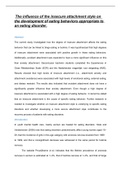The influence of the insecure attachment style on
the development of eating behaviors appropriate to
an eating disorder.
Abstract
The current study investigated how the degree of insecure attachment affects the eating
behavior that can be linked to binge eating or bulimia. It was hypothesized that high degrees
of insecure attachment were associated with positive growth in these eating behaviors.
Additionally, avoidant attachment was expected to have a more significant influence on this
than anxiety attachment. Second-year bachelor students completed the Experiences in
Close Relationships Scale (ECR) and the Nederlandse vragenlijst voor eetgedrag (NVE).
Results showed that high levels of insecure attachment (i.e., attachment anxiety and
attachment avoidance) were associated with high levels of emotional eating, external eating,
and dietary restraint. The results also indicated that avoidant attachment does not have a
significantly greater influence than anxiety attachment. Even though a high degree of
insecure attachment is associated with a high degree of eating behavior, it cannot be stated
that an insecure attachment is the cause of specific eating behavior. Further research is
needed to investigate whether an insecure attachment style is underlying to specific eating
disorders and whether developing a more secure attachment style contributes to the
recovery process of patients with eating disorders.
Introduction
In youth mental health care, mainly women are treated for eating disorders. Hoek and
Vanderecken (2008) note that eating disorders predominantly affect young women aged 15–
29, that the incidence of girls in this age category with anorexia nervosa doubled from 1989
to 1999, and that a nonsignificant decrease was witnessed in the same period for bulimia
nervosa.
The website Proud2beme (n.d.) indicates that the lifetime prevalence of anorexia
nervosa in women is estimated at 1–4%, that of bulimia nervosa at 1–2%, and that of binge
, eating disorder at 1–4%. Furthermore, 50% of patients with anorexia recover completely,
30% recover partially, and 15% do not recover at all and 5% dies (Via Laura, 2020).
Proud2beme show an average treatment duration of an eating disorder for adolescence
between two and five years. Men hardly ever report having an eating disorder (Hoek &
Vandercken, 2008). Men’s risk of developing an eating disorder is estimated at 0.16–0.3%
for anorexia, 0.1–0.5% for bulimia, and 1–3% for binge eating (GGZ standaarden, 2022).
The hypothesis of this study is that there are types of parental relationships that
appear to influence the prevalence of eating disorders. Through this study, an attempt was
made to examine the degree of influence of the parent-child dynamic. To examine this
dynamic the attachment theory will be used.
The standard treatment program for an eating disorder consists of medical
monitoring, cognitive behavioral therapy, and peer counseling. Additionally, parents always
receive psychoeducation regarding eating disorders and family therapy depending on the
type of eating disorder, request for help from parents, and destructive family patterns
(Eetstoornissen Mutsaersstichting, 2020, pp 9-11). If the type of attachment relationship
influences the development and maintenance of an eating disorder, then within the current
treatment design, attachment-focused treatment is unjustifiably neglected. Specific
attachment-based treatment such as attachment-based family therapy focuses on
relationship recovery to promote healing from an eating disorder or reduce relapse (Wagner
et al., 2016). Additionally, it has a preventive element because parents’ attachment style can
influence a child’s attachment style.
Much misunderstanding of young people with an eating disorder is present in their
environment, as it is often assumed that an eating disorder is only about the intake of food.
Spanger and Zimmermann (2000) indicate that within attachment theory, the inner working
model were postulated by John Bowlby as intra-psychic organizations based on individual
experiences. Inner working models included emotional and motivational as well as cognitive
knowledge and representations about the self as (un)worthy of love. In contrast, the negative
inner working model and rebellious behavior are often not seen as part of the eating disorder.





